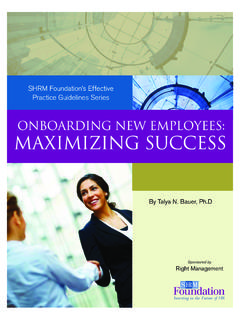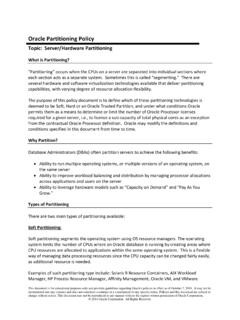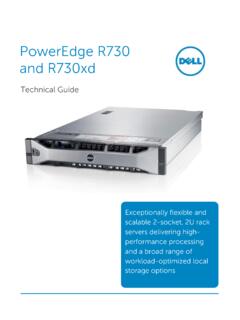Transcription of Platform Firmware Resiliency Guidelines - NIST
1 NIST Special Publication 800-193. Platform Firmware Resiliency Guidelines Andrew Regenscheid This publication is available free of charge from: C O M P U T E R S E C U R I T Y. NIST Special Publication 800-193. Platform Firmware Resiliency Guidelines Andrew Regenscheid Computer Security Division Information Technology Laboratory This publication is available free of charge from: May 2018. Department of Commerce Wilbur L. Ross, Jr., Secretary National Institute of Standards and Technology Walter Copan, NIST Director and Under Secretary of Commerce for Standards and Technology Authority This publication has been developed by NIST in accordance with its statutory responsibilities under the Federal Information Security Modernization Act (FISMA) of 2014, 44 3551 et seq., Public Law ( ) 113-283. NIST is responsible for developing information security standards and Guidelines , including minimum requirements for federal information systems, but such standards and Guidelines shall not apply to national security systems without the express approval of appropriate federal officials exercising policy authority over such systems.
2 This guideline is consistent with the requirements of the Office of Management and Budget (OMB) Circular A-130. Nothing in this publication should be taken to contradict the standards and Guidelines made mandatory and binding on federal agencies by the Secretary of Commerce under statutory authority. Nor should these Guidelines be interpreted as altering or superseding the existing authorities of the Secretary of Commerce, Director of the OMB, or any other federal official. This publication may be used by nongovernmental organizations on a voluntary basis and is not subject to copyright in the United States. Attribution would, however, be appreciated by NIST. National Institute of Standards and Technology Special Publication 800-193. Natl. Inst. Stand. Technol. Spec. Publ. 800-193, 45 pages (May 2018). CODEN: NSPUE2. This publication is available free of charge from: Certain commercial entities, equipment, or materials may be identified in this document in order to describe an experimental procedure or concept adequately.
3 Such identification is not intended to imply recommendation or endorsement by NIST, nor is it intended to imply that the entities, materials, or equipment are necessarily the best available for the purpose. There may be references in this publication to other publications currently under development by NIST in accordance with its assigned statutory responsibilities. The information in this publication, including concepts and methodologies, may be used by federal agencies even before the completion of such companion publications. Thus, until each publication is completed, current requirements, Guidelines , and procedures, where they exist, remain operative. For planning and transition purposes, federal agencies may wish to closely follow the development of these new publications by NIST. Organizations are encouraged to review all draft publications during public comment periods and provide feedback to NIST. Many NIST cybersecurity publications, other than the ones noted above, are available at Comments on this publication may be submitted to: National Institute of Standards and Technology Attn: Computer Security Division, Information Technology Laboratory 100 Bureau Drive (Mail Stop 8930) Gaithersburg, MD 20899-8930.
4 Email: All comments are subject to release under the Freedom of Information Act (FOIA). NIST SP 800-193 Platform Firmware Resiliency Guidelines . Reports on Computer Systems Technology The Information Technology Laboratory (ITL) at the National Institute of Standards and Technology (NIST) promotes the economy and public welfare by providing technical leadership for the Nation's measurement and standards infrastructure. ITL develops tests, test methods, reference data, proof of concept implementations, and technical analyses to advance the development and productive use of information technology. ITL's responsibilities include the development of management, administrative, technical, and physical standards and Guidelines for the cost-effective security and privacy of other than national security-related information in federal information systems. The Special Publication 800-series reports on ITL's research, Guidelines , and outreach efforts in information system security, and its collaborative activities with industry, government, and academic organizations.
5 This publication is available free of charge from: Abstract This document provides technical Guidelines and recommendations supporting Resiliency of Platform Firmware and data against potentially destructive attacks. The Platform is a collection of fundamental hardware and Firmware components needed to boot and operate a system. A. successful attack on Platform Firmware could render a system inoperable, perhaps permanently, or requiring reprogramming by the original manufacturer, resulting in significant disruptions to users. The technical Guidelines in this document promote Resiliency in the Platform by describing security mechanisms for protecting the Platform against unauthorized changes, detecting unauthorized changes that occur, and recovering from attacks rapidly and securely. Implementers, including Original Equipment Manufacturers (OEMs) and component/device suppliers, can use these Guidelines to build stronger security mechanisms into platforms. System administrators, security professionals, and users can use this document to guide procurement strategies and priorities for future systems.
6 Keywords BIOS; Code signing; Firmware ; Option ROM; Platform Firmware ii NIST SP 800-193 Platform Firmware Resiliency Guidelines . Acknowledgements The author, Andrew Regenscheid of the National Institute of Standards and Technology (NIST), wishes to thank his colleagues who reviewed drafts of this document and contributed to its technical content. In particular, NIST appreciates the contributions from experts from industry and government who helped guide this work. These experts included Chirag Schroff from Cisco;. Mukund Khatri from Dell; CJ Coppersmith, Gary Campbell, Shiva Dasari, and Tom Laffey from Hewlett Packard Enterprise; Jim Mann from HP Inc.; Charles Palmer from IBM; Bob Hale, David Riss, and Vincent Zimmer from Intel Corporation; Paul England and Rob Spiger from Microsoft, and Shane Steiger. NIST would also like to acknowledge and thank Kevin Bingham, Cara Steib, and Mike Boyle, This publication is available free of charge from: from the National Security Agency, who provided substantial contributions to this document, as well as Jeffrey Burke from Noblis NSP.
7 Audience The intended audience for this document includes system and Platform device vendors of computer systems, including manufacturers of client, servers, and networking devices. The security principles and recommendations contained in this document should be broadly applicable to other classes of systems with updatable Firmware , including Internet of Things devices, embedded systems, and mobile devices. The technical Guidelines assume readers have expertise in the Platform architectures and are targeted primarily at developers and engineers responsible for implementing Firmware -level security technologies in systems and devices. Trademark Information All product names are registered trademarks or trademarks of their respective companies iii NIST SP 800-193 Platform Firmware Resiliency Guidelines . Executive Summary Modern computing system architectures can be thought of in layers. The top layers are software, composed of the operating system and applications. While these provide most of the functional capabilities employed by users, they rely on functions and services provided by the underlying layers, which this document collectively refers to as the Platform .
8 The Platform includes the hardware and Firmware components necessary to initialize components, boot the system, and provide runtime services implemented by hardware components. Platform Firmware , and its associated configuration data, is critical to the trustworthiness of a computing system. Much of this Firmware is highly privileged in the system architectures, and This publication is available free of charge from: because this Firmware is necessary for the system to operate, repairing this Firmware can be challenging. A successful attack on Platform Firmware could render a system inoperable, perhaps permanently or requiring reprogramming by the original manufacturer, resulting in significant disruptions to users. Other sophisticated malicious attacks could attempt to inject persistent malware in this Firmware , modifying critical low-level services to disrupt operations, exfiltrate data, or otherwise impact the security posture of a computer system. Earlier NIST publications have addressed the threat of attacks on one particular type of Platform Firmware : boot Firmware , commonly known as the Basic Input/Output System (BIOS).
9 However, the Platform consists of many other devices with Firmware and configuration data. These devices, including storage and network controllers, graphics processing units, and service processors, are also highly-privileged and needed for systems to behave securely and reliably. This document provides technical Guidelines intended to support Resiliency of platforms against potentially destructive attacks. These Guidelines are based on the following three principles: Protection: Mechanisms for ensuring that Platform Firmware code and critical data remain in a state of integrity and are protected from corruption, such as the process for ensuring the authenticity and integrity of Firmware updates. Detection: Mechanisms for detecting when Platform Firmware code and critical data have been corrupted. Recovery: Mechanisms for restoring Platform Firmware code and critical data to a state of integrity in the event that any such Firmware code or critical data are detected to have been corrupted, or when forced to recover through an authorized mechanism.
10 Recovery is limited to the ability to recover Firmware code and critical data. These Guidelines are intended to address platforms in personal computer (PC) clients, servers, and network devices, but should be broadly applicable to other classes of systems. Implementers, including Original Equipment Manufacturers (OEMs) and component/device suppliers, can use these Guidelines to build stronger security mechanisms into platforms. System administrators, security professionals, and users can use this document to guide procurement strategies and priorities for future systems. iv NIST SP 800-193 Platform Firmware Resiliency Guidelines . Table of Contents Executive Summary .. iv 1 Introduction .. 1. Purpose ..1. Audience ..1. Applicability and Document Structure ..2. 2 Platform Architecture .. 3. This publication is available free of charge from: Platform Devices ..4. Code and Data in Platform Devices ..7. Code .. 7. Data .. 7. 3 Principles and Key Concepts .. 10. Principles Supporting Platform Resiliency Properties.
















